Semantic Segmentation of Some Rock-Forming Mineral Thin Sections Using Deep Learning Algorithms: A Case Study from the Nikeiba Area, South Eastern Desert, Egypt
Abstract
:1. Introduction
2. Materials and Methods
2.1. Geologic Setting and Petrography of the Study Area
2.2. Image Datasets
2.3. Preparing Thin-Section Samples for Deep Learning Analysis
2.3.1. Train, Validation, and Testing Datasets
2.3.2. CNN Architectures and Models
- Exploring the U-Net Architecture: An Overview of its Structure for Efficient Image Segmentation U-Net is a convolutional neural network architecture developed primarily for biomedical image segmentation. This architecture is notable for its efficiency and accuracy in segmenting images, even with limited data. The structure of U-Net can be described in four main sections:
- Downsampling (Contracting Path): The first part of U-Net is the contracting path, which is a typical convolutional network. This path contains the continual application of two 3 × 3 convolutions (unpadded convolutions), each followed by a rectified linear unit (ReLU) and a 2 × 2 max pooling operation with stride 2 for downsampling. At each downsampling step, the number of feature channels is doubled. This part of the network captures the context in the input image, essential for accurate segmentation.
- Bottleneck: After several layers of downsampling, the U-Net reaches its bottleneck. This is the lowest level of the network, where it has the smallest spatial dimension of feature maps. In the bottleneck, two 3 × 3 convolutions are applied, followed by a ReLU. This section is crucial as it allows the network to process features at the lowest resolution, capturing the most abstract representations of the input data.
- Upsampling (Expanding Path): Following the bottleneck, the network then transitions into the expansive path, which includes a sequence of upsampling and convolution operations. The upsampling of the feature map is followed by a 2 × 2 convolution (“up-convolution”) that halves the number of feature channels. Then, a concatenation is performed with the correspondingly cropped feature map from the contracting path. This step is crucial for the network to learn precise localization, a critical aspect of accurate segmentation.
- Final Layer: The final layer of the network is a 1 × 1 convolution that maps each feature vector to the desired number of classes in the output segmentation map. This layer produces the final segmentation map, where each pixel in the image is classified into a specific class. The architecture’s use of expansive paths and concatenation with high-resolution features from the contracting path allows for precise localization and detailed segmentation.
3. Results and Discussion
3.1. Experiments Setup
3.2. Comparing the Two Datasets
- Quartz: The first dataset shows strong precision at 0.81 and recall at 0.85, leading to a balanced F1 score of 0.83, whereas the second dataset of the Gabal Nikeiba area displays excellent precision at 0.91 and recall (0.79) (Table 2), leading to a very high F1 score. This indicates a reliable performance in correctly identifying quartz and effectively reducing false negatives (Figure 8 and Figure 9).
- Plagioclase and Biotite: These minerals demonstrate high precision in the two datasets, ranging from 0.77 to 0.90, and recall from 0.77 to 0.98 (Table 2), suggesting the model’s strong capability in accurately identifying these minerals and consistently detecting their instances (Figure 8 and Figure 9).
- Riebeckite and Arfvedsonite: These minerals belong to alkali amphibole and are present in the three different types of the Gabal Nikeiba granites (syenogranite, alkali feldspar granites, and quartz syenites) (Figure 5). They show a very high precision range from 0.84 to 0.95 and recall range from 0.77 to 0.90, leading to a strong F1 score of 0.80 and 0.92 (Table 2). This result exhibits the accuracy of the model in identifying and detecting these minerals (Figure 9).
- Muscovite: It shows moderate precision (0.79) and moderate recall (0.62), resulting in a moderate F1 score of 0.69 in the Nikeiba area, which implies the moderate performance of the model in both identifying and detecting the muscovite (Figure 9d).
- Chlorite, Olivine, and Serpentine: These minerals run only in the first dataset, and they exhibit excellent precision ranging from 0.87 to 0.89 and recall from 0.80 to 0.98, resulting in a high F1 score of 0.84, 0.91, and 0.93, respectively (Table 2), indicating that the model shows exceptional performance in both accurately identifying and consistently detecting chlorite, olivine, and serpentine (Figure 8d–h).
- Titanite and Talc: These classes belong to the first dataset, and they have high precision (0.78 and 0.94, respectively; Table 2) but moderate recall (both at 0.77 and 0.76; Table 2), indicating the model’s effectiveness in correctly identifying them, though with some missed instances (Figure 8g–i).
- Tourmaline: It also runs in the first dataset and has perfect precision (1.00); its recall is significantly lower at 0.62, leading to an F1 score of 0.77 (Table 2). This suggests that while the model accurately identifies tourmaline, when it detects it, it misses a considerable number of instances (Figure 8j).
- Apatite: It is an accessory mineral in all the granitic phases of the Nikeiba area (Figure 4a). It has excellent precision (0.92) and low recall (0.51), leading to an F1 score of 0.66 (Table 2). This implies that the model accurately identifies and detects apatite with some missed instances (Figure 9a).
- Background: Notably, the model achieves a moderate to high precision range (0.68 to 0.92) in identifying the background in the two datasets but has a low recall (0.26 to 0.46, respectively), leading to a lower F1 score range from 0.40 to 0.55 (Table 2). This implies that while the model accurately identifies background, when it does, it often fails to detect it.
4. Conclusions
Author Contributions
Funding
Data Availability Statement
Acknowledgments
Conflicts of Interest
References
- Saxena, N.; Mavko, G. Estimating elastic moduli of rocks from thin sections: Digital rock study of 3D properties from 2D images. Comput. Geosci. 2016, 88, 9–21. [Google Scholar] [CrossRef]
- Saxena, N.; Mavko, G.; Hofmann, R.; Srisutthiyakorn, N. Estimating permeability from thin sections without reconstruction: Digital rock study of 3D properties from 2D images. Comput. Geosci. 2017, 102, 79–99. [Google Scholar] [CrossRef]
- Saxena, N.; Day-Stirrat, R.J.; Hows, A.; Hofmann, R. Application of deep learning for semantic segmentation of sandstone thin sections. Comput. Geosci. 2021, 152, 104778. [Google Scholar] [CrossRef]
- Das, R.; Mondal, A.; Chakraborty, T.; Ghosh, K. Deep neural networks for automatic grain-matrix segmentation in plane and cross-polarized sandstone photomicrographs. Appl. Intell. 2021, 52, 2332–2345. [Google Scholar] [CrossRef]
- Leichter, A.; Almeev, R.R.; Wittich, D.; Beckmann, P.; Rottensteiner, F.; Holtz, F.; Sester, M. Automated segmentation of olivine phenocrysts in a volcanic rock thin section using a fully convolutional neural network. Front. Earth Sci. 2022, 10, 740638. [Google Scholar] [CrossRef]
- Nath, F.; Asish, S.; Sutradhar, S.; Li, Z.; Shahadat, N.; Debi, H.R.; Hoque, S.S. Rock thin-section analysis and mineral detection utilizing deep learning approach. In Proceedings of the Unconventional Resources Technology Conference, Denver, CO, USA, 13–15 June 2023. [Google Scholar]
- Ransinangue, A.; Labourdette, R.; Houzay, E.; Chehata, N.; Bourillot, R.; Guillon, S.; Dujoncquoy, E. Carbonates Thin Section Segmentation based on a Synthetic Data Training Approach. In Proceedings of the Fourth EAGE Digitalization Conference & Exhibition, Paris, France, 25–27 March 2024. European Association of Geoscientists & Engineers. [Google Scholar]
- Chen, Y.; Yi, Y.; Dai, Y.; Shi, X. A multiangle polarised imaging-based method for thin section segmentation. J. Microsc. 2024, 294, 14–25. [Google Scholar] [CrossRef] [PubMed]
- Zamora, M.A.A.; Kamber, B.S.; Jones, M.W.; Schrank, C.E.; Ryan, C.G.; Howard, D.L.; Paterson, D.J.; Ubide, T.; Murphy, D.T. Tracking element-mineral associations with unsupervised learning and dimensionality reduction in chemical and optical image stacks of thin sections. Chem. Geol. 2024, 650, 121997. [Google Scholar] [CrossRef]
- Li, D.; Zhao, J.; Ma, J. Experimental studies on rock thin-section image classification by deep learning-based approaches. Mathematics 2022, 10, 2317. [Google Scholar] [CrossRef]
- Gazzi, P. The sandstones of the Upper Cretaceous flysch of the Modenese Apennines: Correlations with the Monghidoro flysch. Mineral. Petrogr. Acta 1966, 12, 69–97. [Google Scholar]
- Dickinson, W.R. Interpreting detrital modes of graywacke and arkose. J. Sediment. Res. 1970, 40, 695–707. [Google Scholar]
- Garcia-Garcia, A.; Orts-Escolano, S.; Oprea, S.; Villena-Martinez, V.; Martinez-Gonzalez, P.; Garcia-Rodriguez, J. A survey on deep learning techniques for image and video semantic segmentation. Appl. Soft Comput. 2018, 70, 41–65. [Google Scholar] [CrossRef]
- Tzepkenlis, A.; Marthoglou, K.; Grammalidis, N. Grammalidis, Efficient deep semantic segmentation for land cover classifica-tion using sentinel imagery. Remote Sens. 2023, 15, 2027. [Google Scholar] [CrossRef]
- Geiger, A.; Lenz, P.; Urtasun, R. Are we ready for autonomous driving? The KITTI vision benchmark suite. In Proceedings of the 2012 IEEE Conference on Computer Vision and Pattern Recognition, Providence, RI, USA, 16–21 June 2012. [Google Scholar]
- Marmanis, D.; Wegner, J.D.; Galliani, S.; Schindler, K.; Datcu, M.; Stilla, U. Semantic segmentation of aerial images with an ensemble of CNSS. ISPRS Ann. Photogramm. Remote Sens. Spat. Inf. Sci. 2016, 3, 473–480. [Google Scholar] [CrossRef]
- Bahrambeygi, B.; Moeinzadeh, H. Comparison of support vector machine and neutral network classification method in hyperspectral mapping of ophiolite mélanges–A case study of east of Iran. Egypt. J. Remote Sens. Space Sci. 2017, 20, 1–10. [Google Scholar] [CrossRef]
- Patmonoaji, A.; Tsuji, K.; Suekane, T. Pore-throat characterization of unconsolidated porous media using watershed-segmentation algorithm. Powder Technol. 2019, 362, 635–644. [Google Scholar] [CrossRef]
- Maitre, J.; Bouchard, K.; Bédard, L.P. Mineral grains recognition using computer vision and machine learning. Comput. Geosci. 2019, 130, 84–93. [Google Scholar] [CrossRef]
- Tang, D.G.; Milliken, K.L.; Spikes, K.T. Machine learning for point counting and segmentation of arenite in thin section. Mar. Pet. Geol. 2020, 120, 104518. [Google Scholar] [CrossRef]
- Mlynarczuk, M.; Skiba, M. The application of artificial intelligence for the identification of the maceral groups and mineral components of coal. Comput. Geosci. 2017, 103, 133–141. [Google Scholar] [CrossRef]
- Pratama, B.; Qodri, M.; Sugarbo, O. Building YoloV4 models for identification of rock minerals in thin section. IOP Conf. Ser. Earth Environ. Sci. 2023, 1151, 012046. [Google Scholar] [CrossRef]
- Dell’aversana, P. An Integrated Deep Learning Framework for Classification of Mineral Thin Sections and Other Geo-Data, a Tutorial. Minerals 2023, 13, 584. [Google Scholar] [CrossRef]
- Zhang, P.; Zhou, J.; Zhao, W.; Li, X.; Pu, L. The edge segmentation of grains in thin-section petrographic images utilising ex-tinction consistency perception network. Complex Intell. Syst. 2024, 10, 1231–1245. [Google Scholar] [CrossRef]
- Su, C.; Xu, S.-j.; Zhu, K.-y.; Zhang, X.-c. Rock classification in petrographic thin section images based on concatenated con-volutional neural networks. Earth Sci. Inform. 2020, 13, 1477–1484. [Google Scholar] [CrossRef]
- Liu, H.; Ren, Y.; Li, X. Rock thin-section analysis and identification based on artificial intelligent technique. Pet. Sci. 2022, 19, 1605–1621. [Google Scholar] [CrossRef]
- Izadi, H.; Sadri, J.; Bayati, M. An intelligent system for mineral identification in thin sections based on a cascade approach. Comput. Geosci. 2017, 99, 37–49. [Google Scholar] [CrossRef]
- Rubo, R.A.; Carneiro, C.d.C.; Michelon, M.F.; Gioria, R.d.S. Digital petrography: Mineralogy and porosity identification using machine learning algorithms in petrographic thin section images. J. Pet. Sci. Eng. 2019, 183, 106382. [Google Scholar] [CrossRef]
- Budennyy, S.; Pachezhertsev, A.; Bukharev, A.; Erofeev, A.; Mitrushkin, D.; Belozerov, B. Image processing and machine learning approaches for petrographic thin section analysis. In Proceedings of the SPE Russian Petroleum Technology Conference, Moscow, Russia, 16–18 October 2017. [Google Scholar] [CrossRef]
- Ładniak, M.; Młynarczuk, M. Search of visually similar microscopic rock images. Comput. Geosci. 2015, 19, 127–136. [Google Scholar] [CrossRef]
- Abdel Gawad, A.E.; Eliwa, H.; Ali, K.G.; Alsafi, K.; Murata, M.; Salah, M.S.; Hanfi, M.Y. Cancer Risk Assessment and Geo-chemical Features of Granitoids at Nikeiba, Southeastern Desert, Egypt. Minerals 2022, 12, 621. [Google Scholar] [CrossRef]
- Stern, R.J.; Hedge, C.E. Geochronologic and isotopic constraints on late Precambrian crustal evolution in the Eastern Desert of Egypt. Am. J. Sci. 1985, 285, 97–127. [Google Scholar] [CrossRef]
- Abo Khashaba, S.M. Integration of Remote Sensing and Geochemical Data for the Exploration of Some Rare Metals-Bearing Gra-Nitic Plutons, Central Eastern Desert, Egypt. Master’s Thesis, Kafrelsheikh University, Kafr El-Shaikh, Egypt, 2022. [Google Scholar]
- Rumelhart, D.E.; Hinton, G.E.; Williams, R.J. Learning representations by back-propagating errors. Nature 1986, 323, 533–536. [Google Scholar] [CrossRef]
- Ronneberger, O.; Fischer, P.; Brox, T. U-net: Convolutional networks for biomedical image segmentation. In International Con-ference on Medical Image Computing and Computer Assisted Intervention; Springer: Berlin/Heidelberg, Germany, 2015; pp. 234–241. [Google Scholar]
- Ioffe, S.; Szegedy, C. Batch normalization: Accelerating deep network training by reducing internal covariate shift. In Proceedings of the International Conference on Machine Learning, PMLR, Lille, France, 6–11 July 2015; pp. 448–456. [Google Scholar]
- Zhang, Z.; Liu, Q.; Wang, Y. Road extraction by deep residual u-net. IEEE Geosci. Remote Sens. Lett. 2018, 15, 749–753. [Google Scholar] [CrossRef]
- Kochkarev, A.; Khvostikov, A.; Korshunov, D.; Krylov, A.; Boguslavskiy, M. Data balancing method for training segmentation neural networks. CEUR Workshop Proc. 2020, 2744, 1–10. [Google Scholar] [CrossRef]
- Kuhn, M.; Johnson, K. Applied Predictive Modeling; Springer: Berlin/Heidelberg, Germany, 2013; p. 26. [Google Scholar]
- Liu, T.; Liu, Z.; Zhang, K.; Li, C.; Zhang, Y.; Mu, Z.; Mu, M.; Xu, M.; Zhang, Y.; Li, X. Research on the generation and annotation method of thin section images of tight oil reservoir based on deep learning. Sci. Rep. 2024, 14, 12805. [Google Scholar] [CrossRef]
- Schwartz, G.M. Alteration of biotite under mesothermal conditions. Econ. Geol. 1958, 53, 164–177. [Google Scholar] [CrossRef]
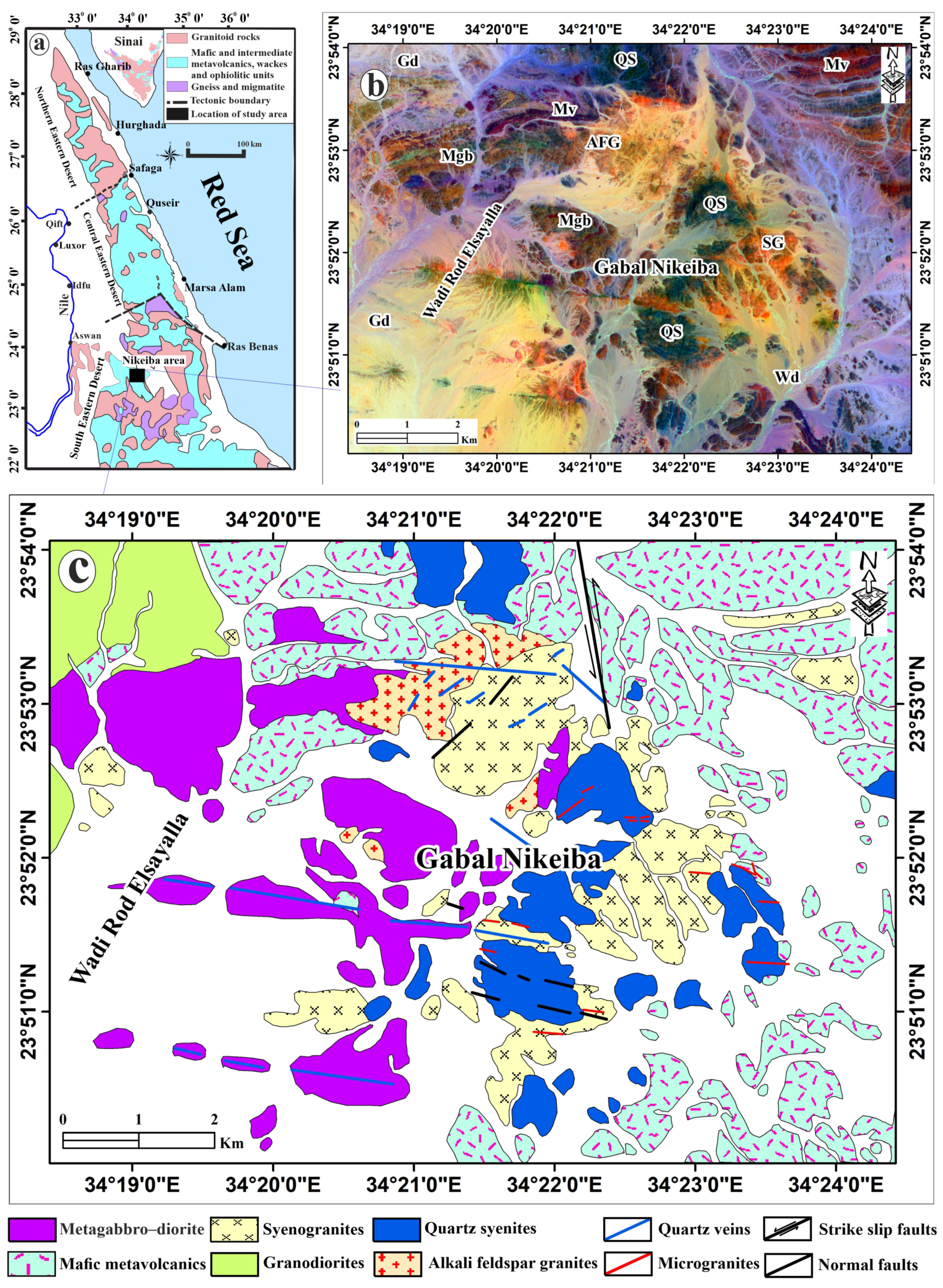

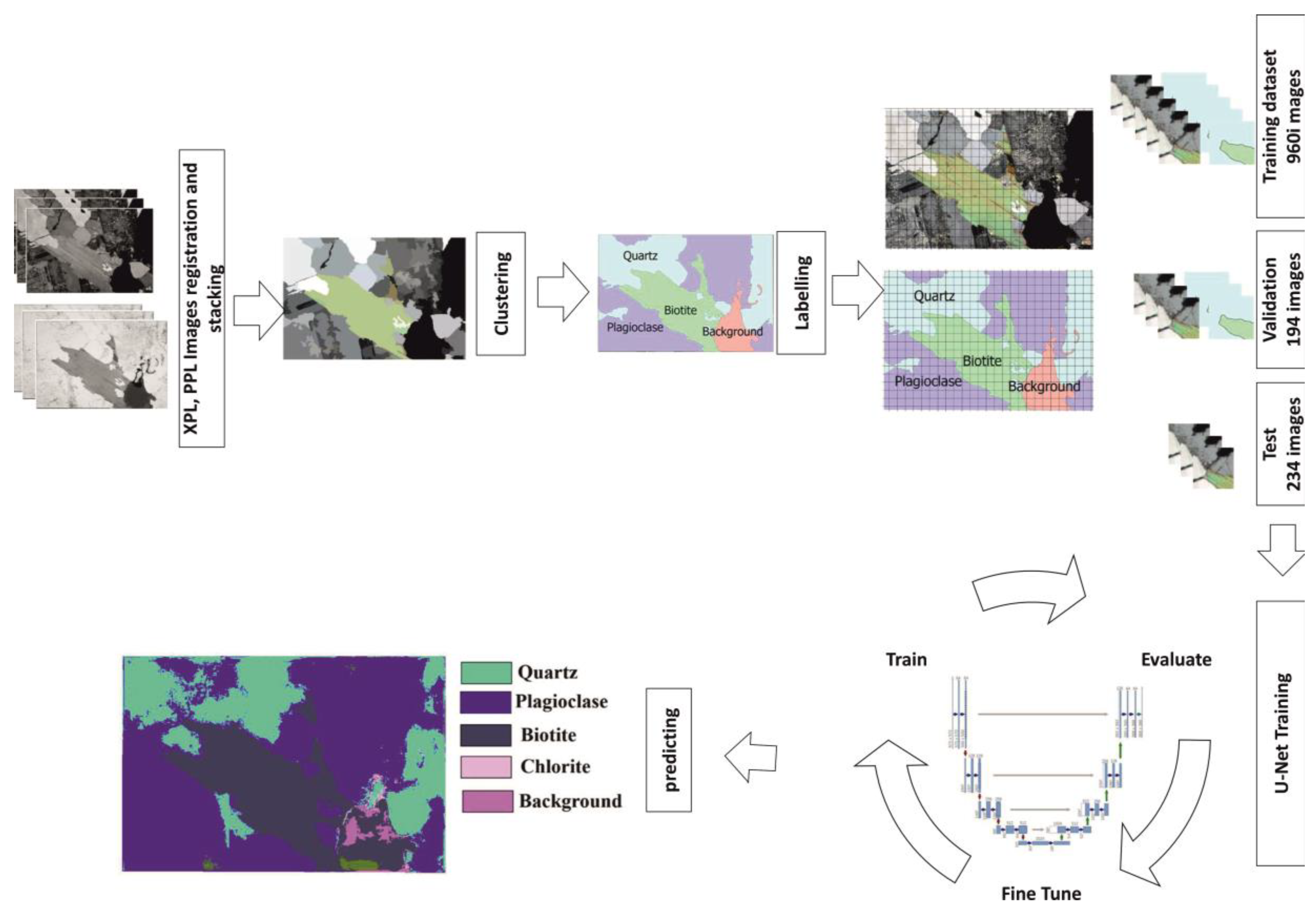

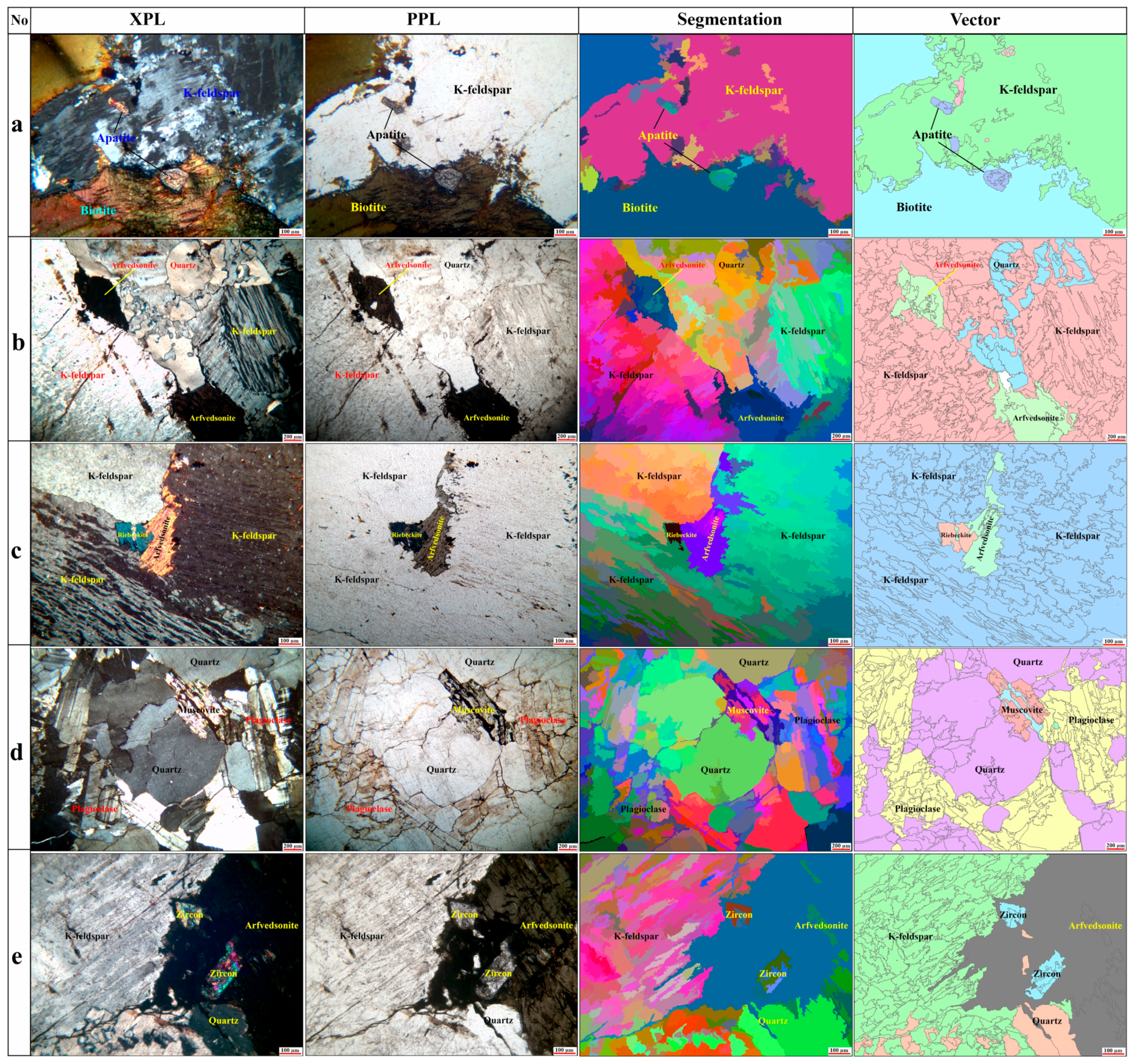
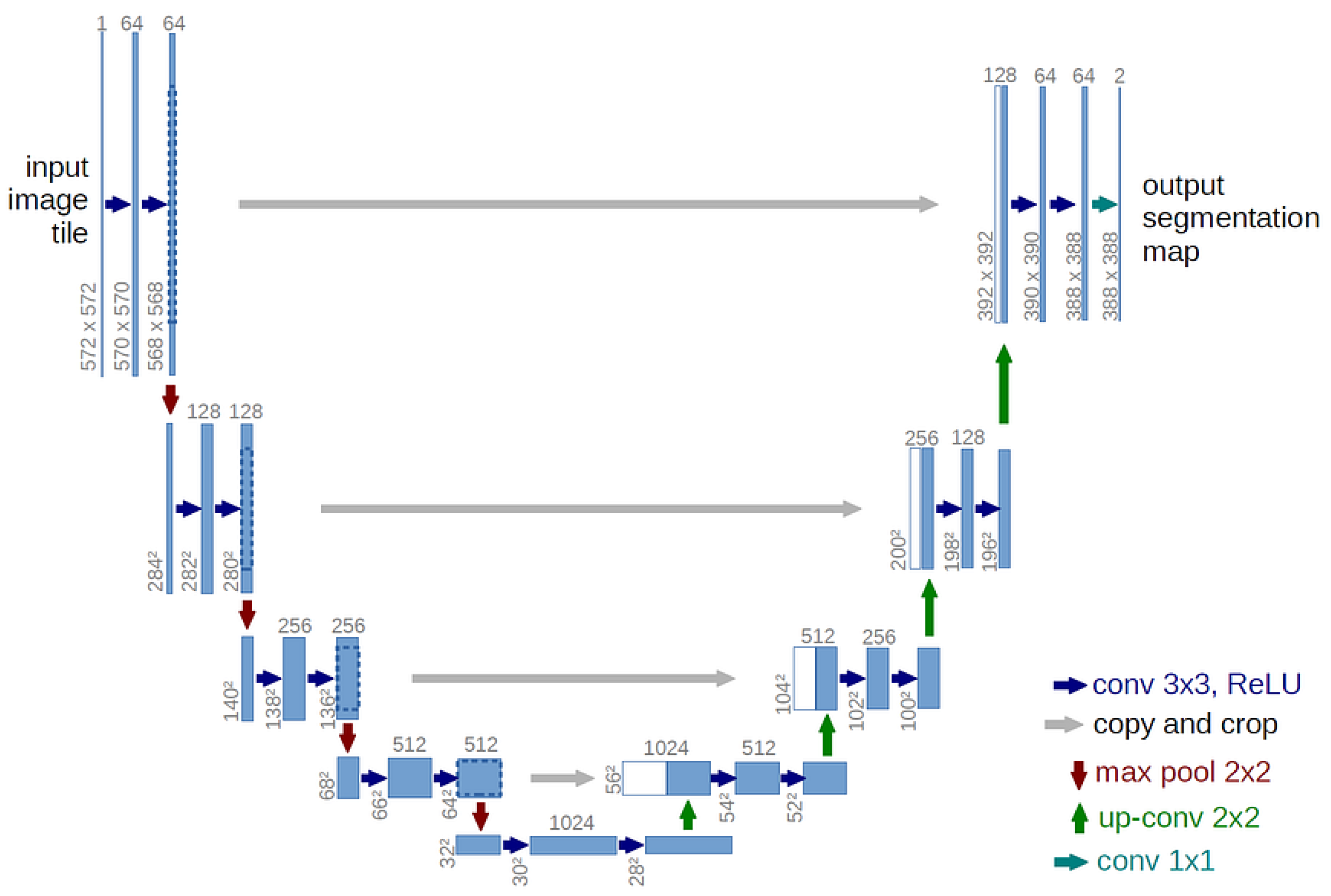
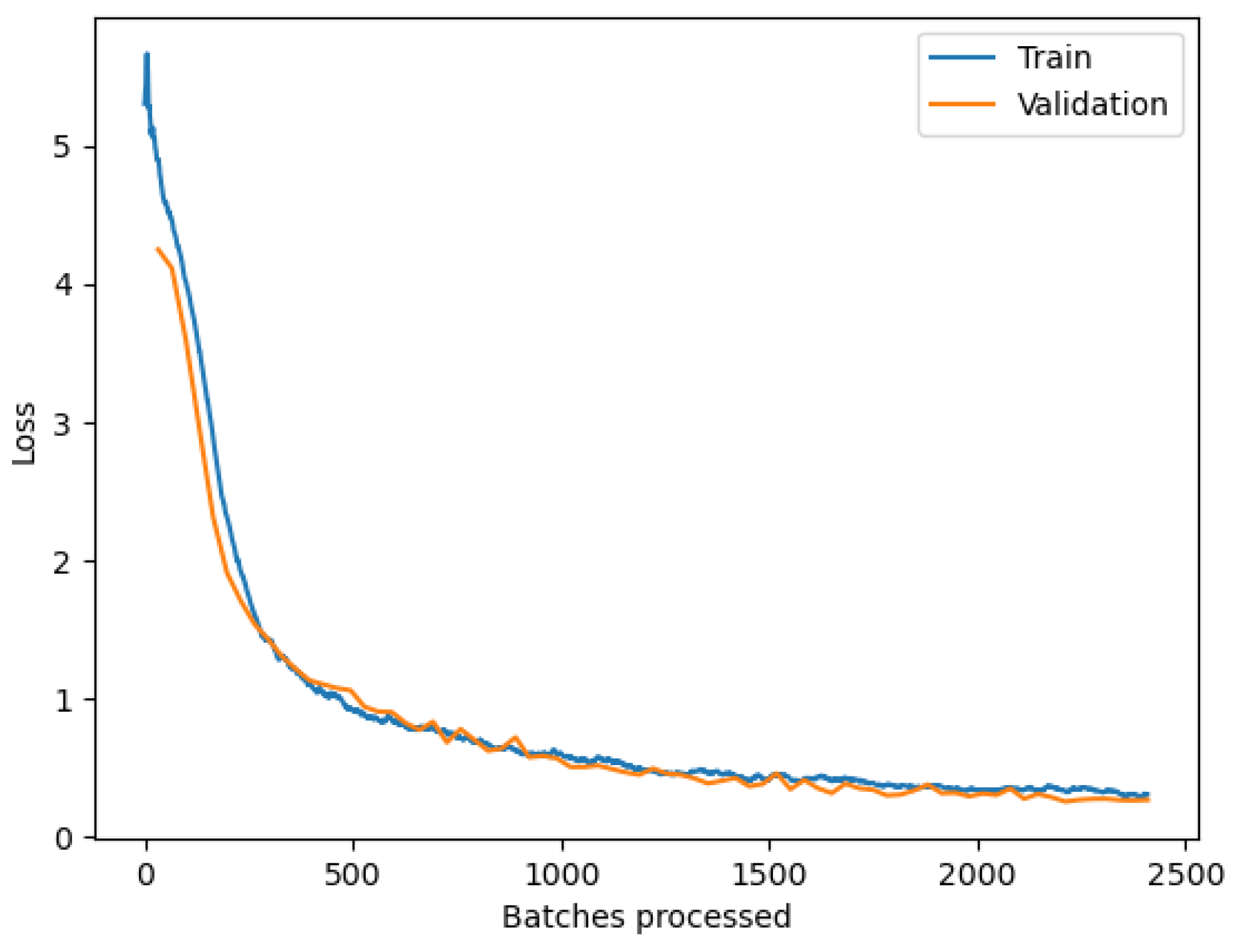
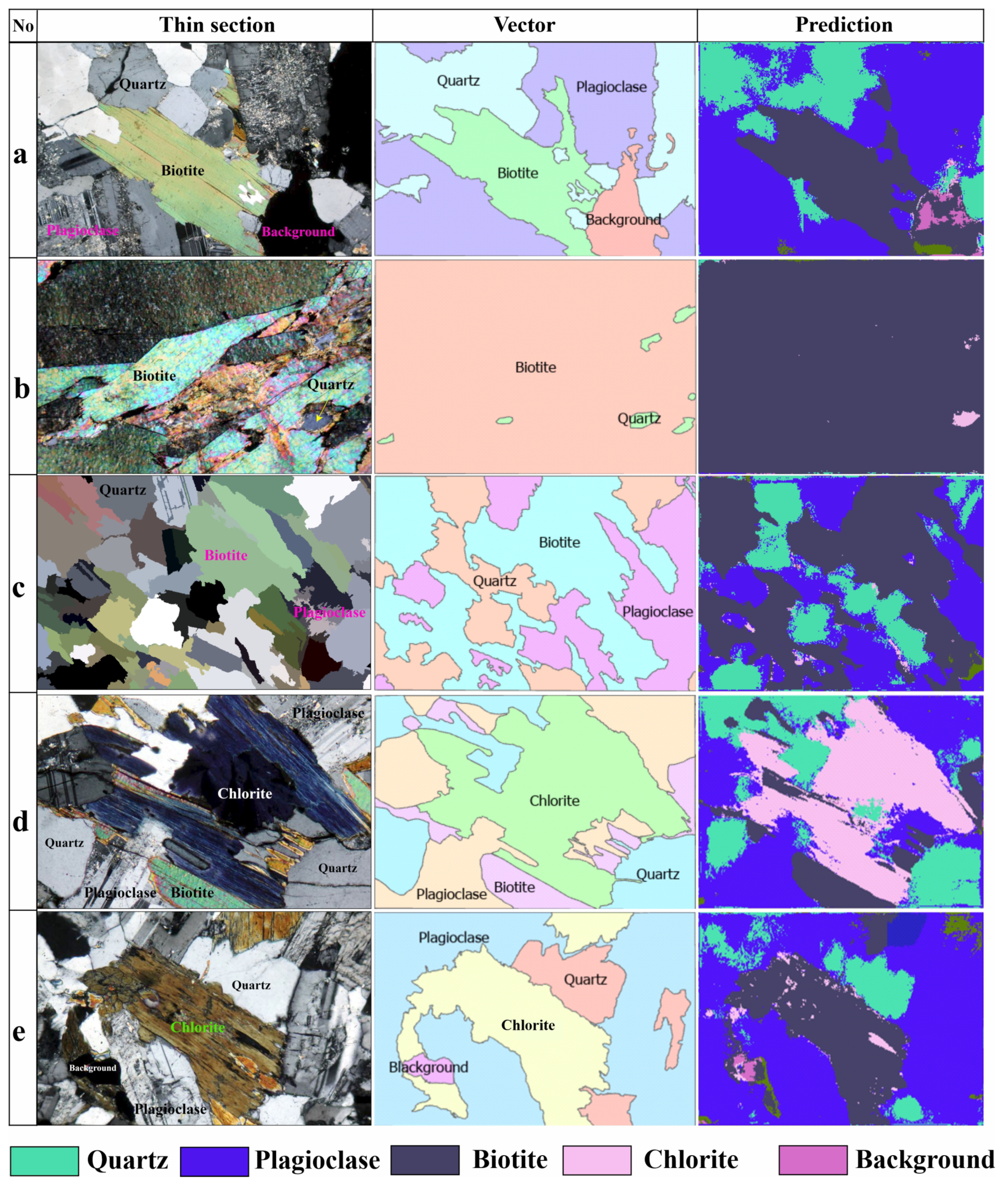


| Hyperparameters | Spanned Range |
|---|---|
| Learn Rate Schedule | Piecewise |
| Learn Rate Drop | Period 2 |
| Learn Rate Drop Factor | 0.8 |
| Initial Learn Rate | 0.001 |
| L2 Regularization | 0.1 |
| Max Epochs | 75 |
| Mini Batch Size | 3 |
| Shuffle | Every epoch |
| The First Dataset from ALEX Strekeisen (https://www.alexstrekeisen.it) | |||||||||||
|---|---|---|---|---|---|---|---|---|---|---|---|
| Metrics | Quartz | Plagioclase | Biotite | Chlorite | Olivine | Serpentine | Tourmaline | Titanite | Talc | Background | Average |
| precision | 0.81 | 0.78 | 0.90 | 0.89 | 0.87 | 0.88 | 1.00 | 0.78 | 0.94 | 0.92 | 0.89 |
| recall | 0.85 | 0.77 | 0.93 | 0.80 | 0.94 | 0.98 | 0.62 | 0.77 | 0.76 | 0.26 | 0.80 |
| F1 | 0.83 | 0.78 | 0.91 | 0.84 | 0.91 | 0.93 | 0.77 | 0.77 | 0.84 | 0.40 | 0.82 |
| The Second Dataset from the Gabal Nikeiba Area, South Eastern Desert, Egypt | |||||||||||
| Metrics | Quartz | Plagioclase | Biotite | K-feldspar | Riebeckite | Arfvedsonite | Muscovite | Apatite | Zircon | Background | Average |
| precision | 0.91 | 0.81 | 0.77 | 0.91 | 0.95 | 0.84 | 0.79 | 0.92 | 0.76 | 0.68 | 0.83 |
| recall | 0.79 | 0.90 | 0.98 | 0.94 | 0.90 | 0.77 | 0.62 | 0.51 | 0.89 | 0.46 | 0.78 |
| F1 | 0.84 | 0.85 | 0.86 | 0.92 | 0.92 | 0.80 | 0.69 | 0.66 | 0.82 | 0.55 | 0.79 |
| The First Dataset from ALEX Strekeisen (https://www.alexstrekeisen.it) | |||||||||||||||||||||||||||||||
|---|---|---|---|---|---|---|---|---|---|---|---|---|---|---|---|---|---|---|---|---|---|---|---|---|---|---|---|---|---|---|---|
| Input thin-section image | Figure 8a | Figure 8b | Figure 8c | ||||||||||||||||||||||||||||
| Ground truth mineral | Quartz | Plagioclase | Biotite | Background | Biotite | Quartz + Background | Quartz | Plagioclase | Biotite | Background | |||||||||||||||||||||
| Percentage | 32.03 | 41.77 | 18.99 | 7.21 | 98.39 | 1.61 | 28.09 | 36.60 | 63.40 | 0.00 | |||||||||||||||||||||
| Predicted mineral | Quartz | Plagioclase | Biotite | Background | Biotite | Quartz + Background | Quartz | Plagioclase | Biotite | Background | |||||||||||||||||||||
| Percentage | 23.00 | 51.40 | 22.37 | 3.22 | 97.33 | 2.67 | 15.50 | 37.14 | 45.26 | 2.11 | |||||||||||||||||||||
| Difference | 9.03 | −9.63 | −3.38 | 3.99 | 1.06 | −1.06 | 13.41 | −0.54 | 18.15 | −2.11 | |||||||||||||||||||||
| Input thin-section image | Figure 8d | Figure 8e | Figure 8f | ||||||||||||||||||||||||||||
| Ground truth mineral | Quartz | Plagioclase | Biotite | Chlorite | Background | Quartz | Plagioclase | Biotite | Background | Plagioclase | Olivine | Background | |||||||||||||||||||
| Percentage | 21.23 | 28.81 | 10.60 | 32.85 | 0.26 | 11.97 | 56.73 | 29.76 | 1.54 | 47.85 | 52.15 | 0.00 | |||||||||||||||||||
| Predicted mineral | Quartz | Plagioclase | Biotite | Chlorite | Background | Quartz | Plagioclase | Biotite | Background | Plagioclase | Olivine | Background | |||||||||||||||||||
| Percentage | 22.14 | 32.42 | 12.34 | 39.37 | 0.00 | 9.63 | 59.41 | 24.48 | 6.48 | 42.25 | 56.62 | 1.14 | |||||||||||||||||||
| Difference | −0.91 | −3.61 | −1.74 | 6.52 | −0.26 | 2.33 | −2.68 | 5.28 | −4.94 | 5.60 | −4.46 | −1.14 | |||||||||||||||||||
| Input thin-section image | Figure 8g | Figure 8h | Figure 8i | Figure 8j | |||||||||||||||||||||||||||
| Ground truth mineral | Serpentine | Talc | Background | Serpentine | Talc | Background | Quartz | Biotite | Titanite | Background | Quartz | Tourmaline | Background | ||||||||||||||||||
| Percentage | 76.16 | 23.84 | 0.00 | 75.80 | 24.20 | 0.00 | 86.99 | 5.91 | 6.29 | 0.82 | 84.09 | 11.02 | 4.89 | ||||||||||||||||||
| Predicted mineral | Serpentine | Talc | Background | Serpentine | Talc | Background | Quartz | Biotite | Titanite | Background | Quartz | Tourmaline | Background | ||||||||||||||||||
| Percentage | 76.28 | 22.82 | 0.90 | 78.46 | 21.35 | 0.19 | 85.15 | 5.13 | 6.12 | 3.61 | 84.41 | 10.99 | 4.60 | ||||||||||||||||||
| Difference | −0.11 | 1.01 | −0.90 | −2.66 | 2.85 | −0.19 | 1.84 | 0.78 | 0.17 | −2.79 | −0.32 | 0.03 | 0.29 | ||||||||||||||||||
| The second dataset from the Gabal Nikeiba area, South Eastern Desert, Egypt | |||||||||||||||||||||||||||||||
| Input thin-section image | Figure 9a | Figure 9b | Figure 9c | Figure 9d | Figure 9e | ||||||||||||||||||||||||||
| Ground truth mineral | K-feldspar | Biotite | Apatite | Quartz | K-feldspar | Arfvedsonite | Background | K-feldspar | Arfvedsonite | Riebeckite | Background | Quartz | Plagioclase | Muscovite | Quartz | K-feldspar | Arfvedsonite | Zircon | |||||||||||||
| Percentage | 60.69 | 37.31 | 1.39 | 8.94 | 81.58 | 9.39 | 0.10 | 94.37 | 4.18 | 1.34 | 00.11 | 50.50 | 45.66 | 3.84 | 7.41 | 51.30 | 38.78 | 2.51 | |||||||||||||
| Predicted mineral | K-feldspar | Biotite | Apatite | Quartz | K-feldspar | Arfvedsonite | Background | K-feldspar | Arfvedsonite + Riebeckite | Quartz | Plagioclase | Muscovite | Quartz | K-feldspar | Arfvedsonite | Zircon | |||||||||||||||
| Percentage | 61.58 | 36.80 | 1.62 | 7.36 | 84.69 | 7.85 | 0.11 | 94.05 | 5.95 | 47.94 | 47.56 | 4.50 | 5.09 | 49.20 | 42.35 | 3.36 | |||||||||||||||
| Difference | −0.89 | 0.51 | −0.23 | 1.58 | −3.11 | 1.54 | −0.01 | 0.32 | −1.78 | 2.56 | −1.90 | −0.66 | 2.32 | 2.10 | −3.57 | −0.85 | |||||||||||||||
Disclaimer/Publisher’s Note: The statements, opinions and data contained in all publications are solely those of the individual author(s) and contributor(s) and not of MDPI and/or the editor(s). MDPI and/or the editor(s) disclaim responsibility for any injury to people or property resulting from any ideas, methods, instructions or products referred to in the content. |
© 2024 by the authors. Licensee MDPI, Basel, Switzerland. This article is an open access article distributed under the terms and conditions of the Creative Commons Attribution (CC BY) license (https://creativecommons.org/licenses/by/4.0/).
Share and Cite
Hassan, S.M.; Laban, N.; Abo Khashaba, S.M.; El-Shibiny, N.H.; Bashir, B.; Azer, M.K.; Drüppel, K.; Keshk, H.M. Semantic Segmentation of Some Rock-Forming Mineral Thin Sections Using Deep Learning Algorithms: A Case Study from the Nikeiba Area, South Eastern Desert, Egypt. Remote Sens. 2024, 16, 2276. https://doi.org/10.3390/rs16132276
Hassan SM, Laban N, Abo Khashaba SM, El-Shibiny NH, Bashir B, Azer MK, Drüppel K, Keshk HM. Semantic Segmentation of Some Rock-Forming Mineral Thin Sections Using Deep Learning Algorithms: A Case Study from the Nikeiba Area, South Eastern Desert, Egypt. Remote Sensing. 2024; 16(13):2276. https://doi.org/10.3390/rs16132276
Chicago/Turabian StyleHassan, Safaa M., Noureldin Laban, Saif M. Abo Khashaba, N. H. El-Shibiny, Bashar Bashir, Mokhles K. Azer, Kirsten Drüppel, and Hatem M. Keshk. 2024. "Semantic Segmentation of Some Rock-Forming Mineral Thin Sections Using Deep Learning Algorithms: A Case Study from the Nikeiba Area, South Eastern Desert, Egypt" Remote Sensing 16, no. 13: 2276. https://doi.org/10.3390/rs16132276
APA StyleHassan, S. M., Laban, N., Abo Khashaba, S. M., El-Shibiny, N. H., Bashir, B., Azer, M. K., Drüppel, K., & Keshk, H. M. (2024). Semantic Segmentation of Some Rock-Forming Mineral Thin Sections Using Deep Learning Algorithms: A Case Study from the Nikeiba Area, South Eastern Desert, Egypt. Remote Sensing, 16(13), 2276. https://doi.org/10.3390/rs16132276








